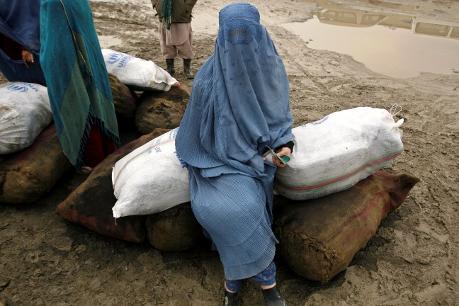AlertNet AidWatch - New Website Gives Lowdown On Global Aid Flows
Katie Nguyen
Feb 9,2011

A displaced Afghan woman receives winter aid from the U.N refugee agency in Kabul
The United States may boast of being the largest single donor of foreign aid in the world, but did you know that, in terms of per person donations, the United Arab Emirates has shown more generosity?
Data compiled by Global Humanitarian Assistance (GHA), a group that monitors international aid flows, shows the United States gave $4.4 billion in humanitarian aid in 2008, which worked out at $14 per American, whereas the UAE (which also happens to be the world's number three oil exporter) gave $111 million in humanitarian aid or $23 per Emirati.
Denmark was even more generous, giving $54 per person - a total of $295 million - in 2008.
And what about Turkey?
It might conjure up the image of an earthquake-prone nation, a receiver of aid. But in 2008, Turkey gave $32 million in humanitarian donations compared with the $12 million it received.
The picture of global aid-giving is complex, says GHA, which unveiled profiles on humanitarian funding for 20 countries on Wednesday, with 20 more to be completed by the end of the month.
"It's not all about a group of what we've traditionally called 'Western donors' giving to what we might call 'recipient donors' any more - if it ever has been that," said GHA programme leader Jan Kellett.
The profiles cover a mix of states that donate aid, states that receive it, and two states that do both.
Graphs show what has been given, when and how. There's information on a country's aid policy as well as background on its governance and security, basic development indicators and data on its contributions to U.N. appeals.
'WEST-TO-REST' MYTH
All these elements together clearly dispel the "west to rest" myth of aid, GHA says.
"There are a lot of donors out there who don't get that much attention within the humanitarian system and are perhaps not quite inside the system but are actually giving substantial amounts of money each and every year," Kellett told AlertNet.
"It's a fact that there are quite a lot of countries that are recipients of aid - sometimes humanitarian, sometimes development - but actually are humanitarian donors at the same time, so that leads us to a much more complicated picture of the way the world interacts when it comes to humanitarian need," Kellett added.
Saudi Arabia is an interesting example of a big donor of humanitarian aid, which remains under many people's radar (although not at AlertNet). In 2008, it gave a total $727 million in humanitarian aid, making it the fifth largest government donor after the United States, the European Commission, Britain and Germany.
"Saudi Arabia has been giving aid for probably more than 30 years, in fact, giving more money and more regular money than a lot of donors within the DAC (a group of the world's wealthiest donor nations)," Kellett said.
Another factor GHA wants to add to its humanitarian aid profile is "domestic response" in recipient countries - in other words, the work done by governments, civil society, individuals, families and communities to deal with a crisis.
"After Cyclone Sidr in 2007, WFP (the U.N. World Food Programme) was feeding about two million people, while actually the Bangladesh government was feeding nine (million)," Kellett noted.
He hopes the profiles will be useful to anyone interested in the effective use of humanitarian aid - from taxpayers and beneficiaries to donor and recipient governments, from relief agencies and advocacy organisations to spending watchdogs and journalists.
"The list is also particularly important when you come to think about what's going to happen with the financial crisis, whether or not there's more pressure on the traditional donors to spend less, and (if so) that means that the humanitarian system is going to look for other donors to fill the void," Kellett said.
Copyright © 2011 Thomson Reuters Foundation
